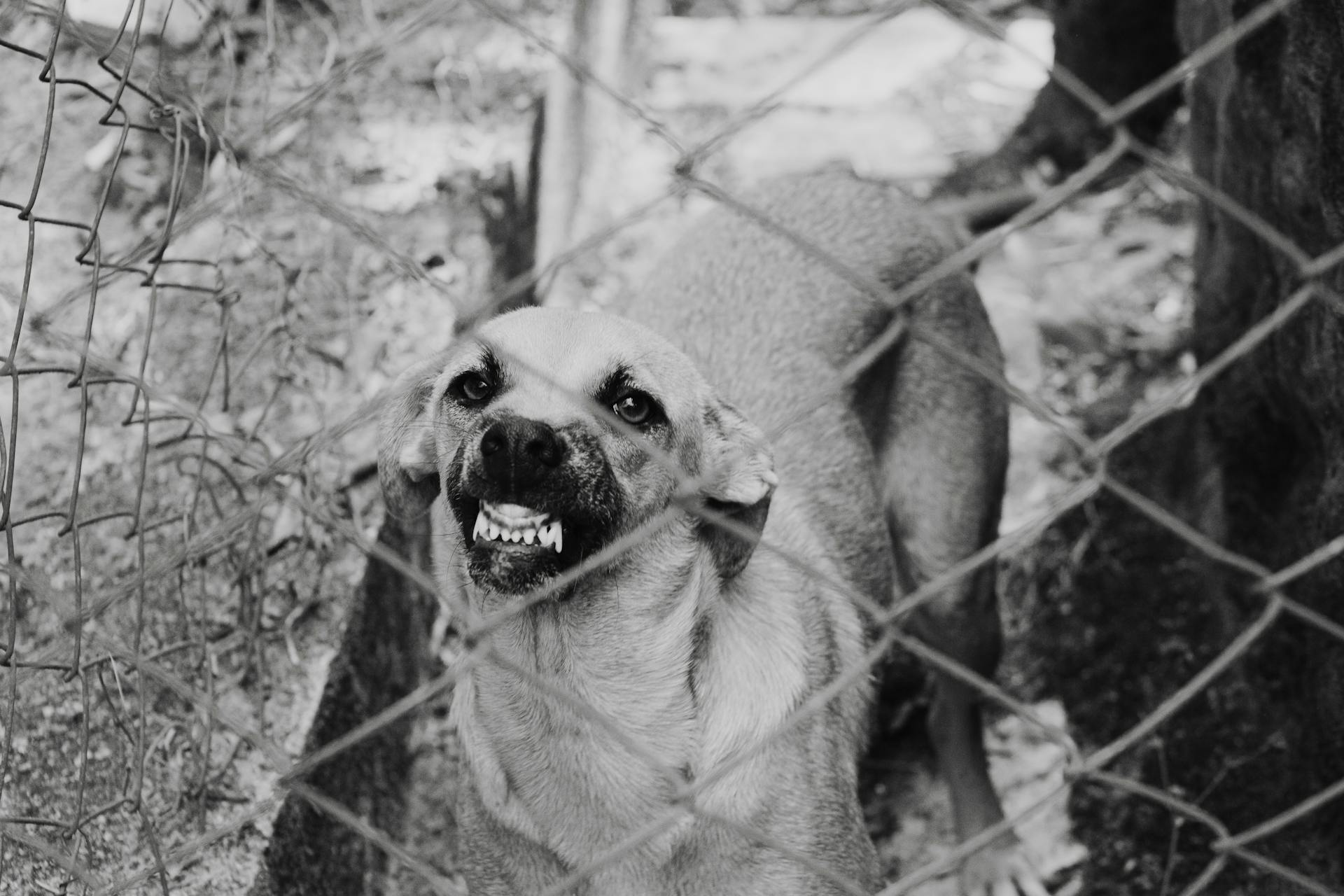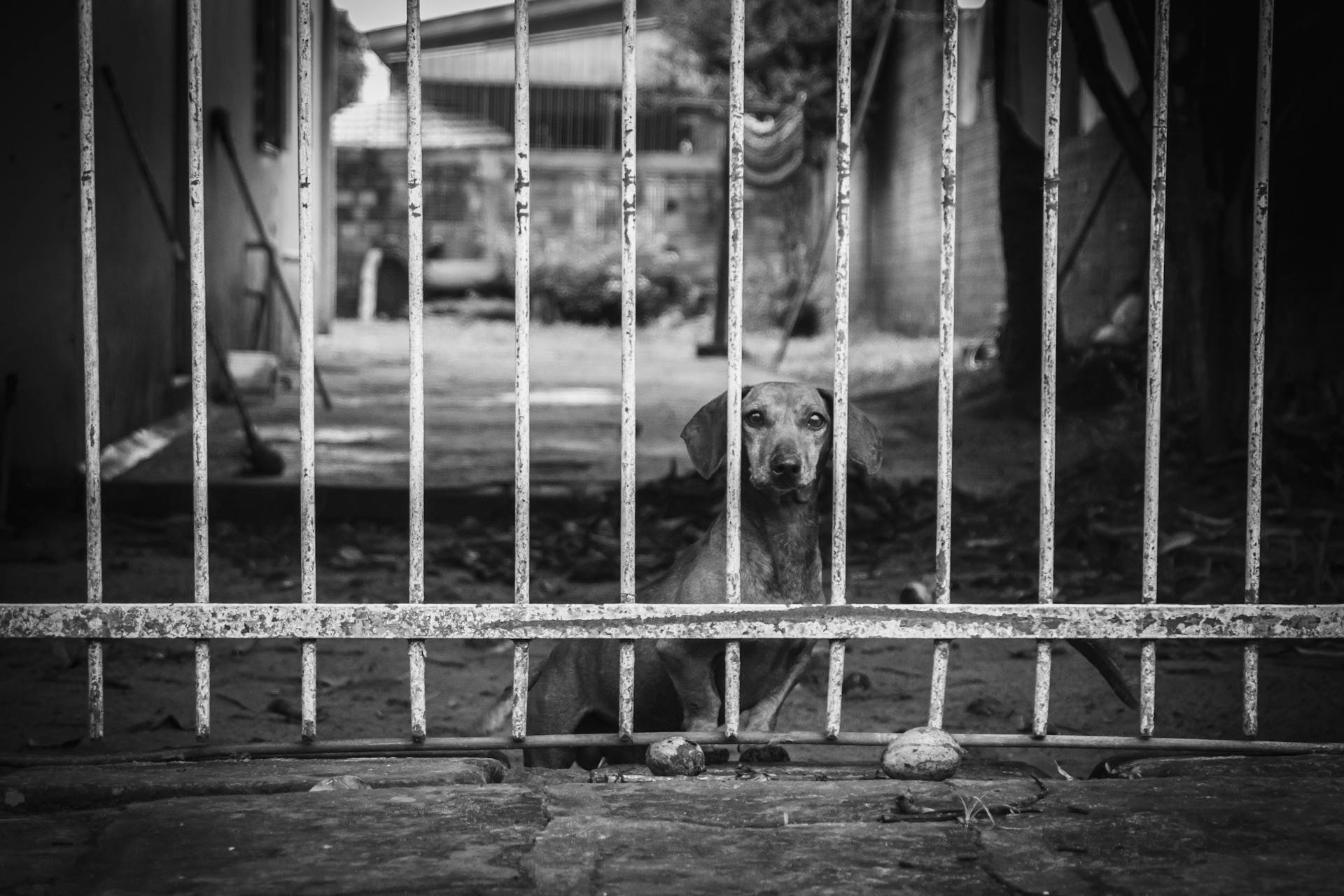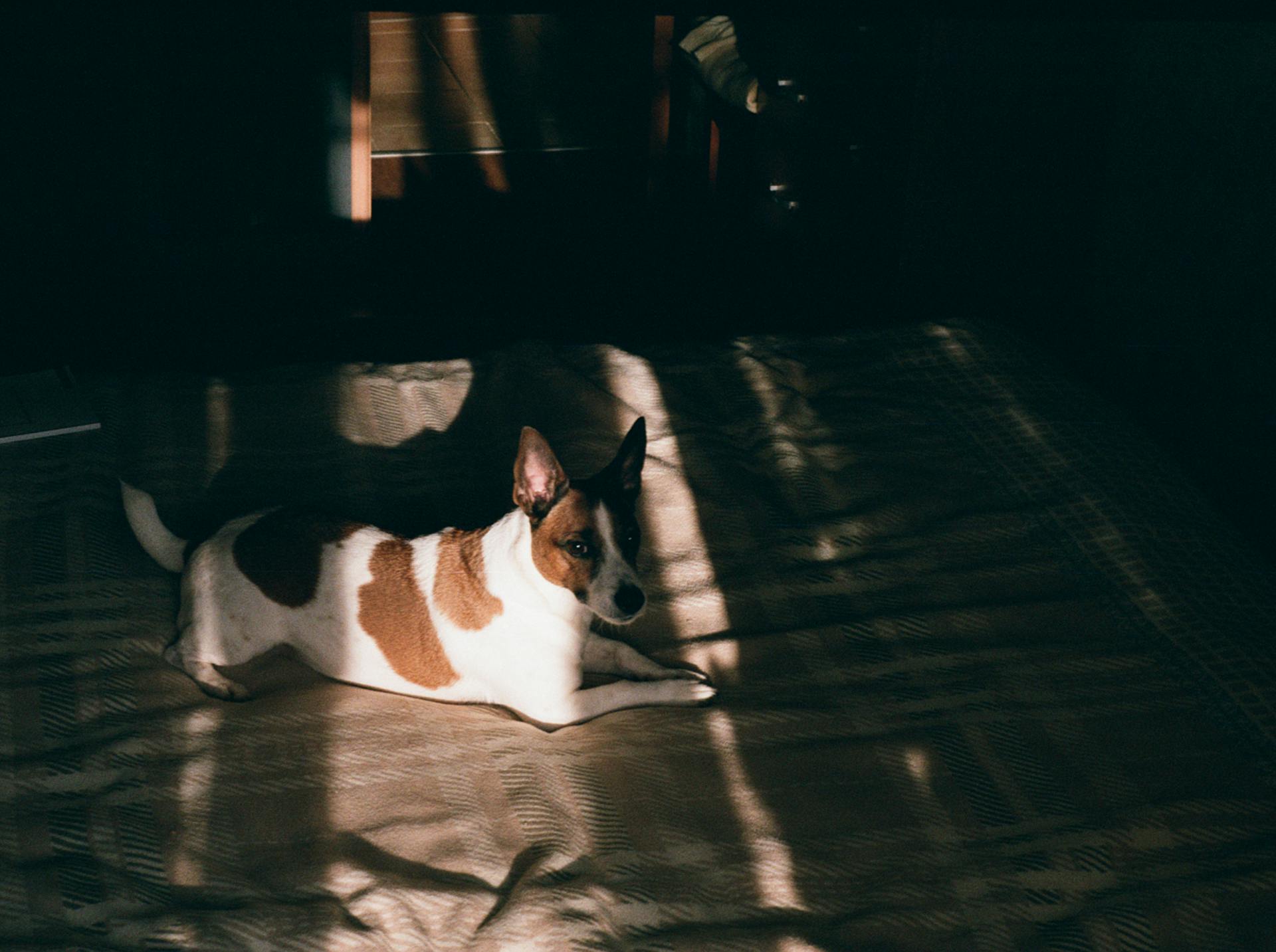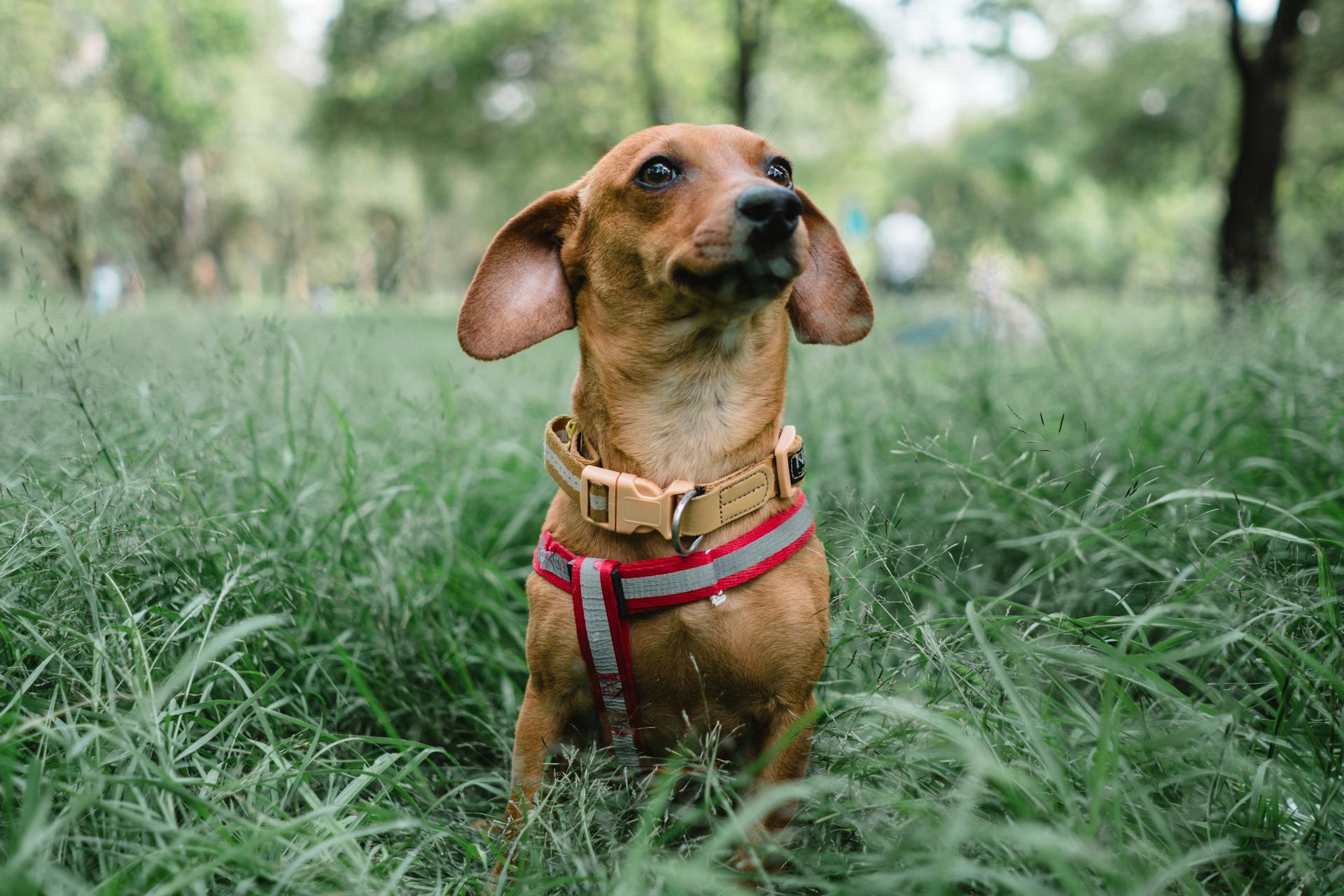
Dog barrier aggression can be a challenging issue for many dog owners. It's a common problem that can arise when a dog is prevented from accessing something they want, such as food, a toy, or a person.
This behavior is often seen in situations where a dog is blocked from entering a room or area, resulting in frustration and anxiety. According to research, dogs that exhibit barrier aggression are more likely to be male and belong to breeds that are known for their protective nature.
Dogs that experience barrier aggression may resort to barking, whining, or even physical aggression to try and overcome the barrier. In some cases, this behavior can escalate quickly, leading to serious consequences.
Understanding the underlying causes of barrier aggression is key to managing the behavior. By identifying the triggers and taking steps to address them, you can help your dog feel more secure and reduce the likelihood of aggressive behavior.
Understanding Dog Barrier Aggression
Dog barrier aggression is a common issue that can be frustrating for both dogs and their owners. It's essential to understand that barrier frustration is a specific type of reactivity that occurs when dogs are confined to a kennel or area.
Dogs exhibiting barrier frustration often display stress behaviors like barking, lunging, and biting at the kennel door. This behavior can be managed with the I Love My Kennel Protocol, which includes gate games and a solid kennel routine.
To break the habit of barrier frustration, it's crucial to work on this behavior from inside the kennel with the dog. This involves talking in a casual, upbeat voice, giving the dog tasty treats, and engaging in fun activities as people or dogs pass by the kennel.
Redirecting the dog's behavior onto a toy is another effective way to manage barrier frustration. This can be done by giving the dog a toy to hold and praising them as they do so each time people or dogs pass by.
Explore further: Why Is My Female Dog Whining and Carrying a Toy
Dogs with barrier frustration need a variety of enrichment toys inside their kennels at all times. This can help keep them occupied and reduce stress.
Fence aggression can be a learned behavior that can be unlearned with proper training and management. Understanding the underlying cause of the behavior is essential to developing an effective management plan.
The prognosis for a dog with fence aggression depends on the severity of the behavior and the owner's commitment to managing it. Some dogs may need lifelong management to prevent aggressive outbursts.
The behavior of fence aggression can vary depending on the breed and personality of the dog. Some breeds are more prone to this type of behavior than others, and some dogs may have a more dominant personality that can exacerbate the behavior.
Here are some common signs of barrier frustration:
- Barking at the kennel door
- Lunging at the kennel door
- Biting at the kennel door
- Spinning
- Gate climbing
- Wall climbing/jumping
Causes and Triggers
Dogs that suffer from fence aggression are often triggered by certain stimuli such as the sound of a barking dog, the sight of a passing vehicle, or the presence of a neighboring dog.
Aggressive behavior can be caused by a variety of factors, including territorial aggression, resource guarding, fear aggression, defensive aggression, frustration-provoked aggression, redirected aggression, and predatory aggression.
Territorial aggression is a common reason for fence aggression, as dogs will protect their home or space from perceived intruders.
Frustration-provoked aggression is another common trigger, as dogs may become frustrated when they're limited to a leash or in a fenced yard.
Redirected aggression occurs when a frustrated and excited dog redirects its aggressive energy towards another animal, human, or object.
Dogs can also direct aggressive behavior towards lifeless objects, such as yard equipment or wheels on vehicles, due to barrier frustration.
Here's an interesting read: Territorial Dog Training
Recognizing Signs and Prevention
Recognizing the signs of dog barrier aggression is crucial for owners to ensure their pet's safety and well-being. These signs can include barking, growling, and lunging at the fence or window.
Barrier frustration is intense frustration on the dog's part at the inability to express normal canine body language and/or interact with other dogs. The restrictive barrier is the leash, fence, or gate, which amplifies the dog's frustration to a point where they can't help their reaction.
To prevent barrier reactivity in dogs, minimize visual and audio access to the stimulus or trigger. This can be achieved by covering the view with visual barriers or closing curtains.
A fresh viewpoint: Signs of Prey Drive in Dogs
Recognizing Signs

Fence aggression in dogs can manifest as barking, growling, and lunging at the fence or window, and if left untreated, it can escalate into a serious safety concern for both the dog and its owner.
The signs of dog barrier aggression, also known as frustration, can include barking, growling, jumping, lunging, or reacting to something from behind a barrier.
A dog's reaction to a trigger or stimulus behind a barrier is not necessarily aggression, but rather a response to fear, overexcitement, stress, anxiety, or frustration.
Barrier frustration can cause a dog to whine, bark, growl, or lunge when they see another dog while on their leash, due to the inability to express normal canine body language and interact with other dogs.
Respecting what the reactive dog is seeing is crucial in understanding their behavior, as they are not necessarily in the wrong, but rather responding to a perceived threat.
If a dog's response seems out of proportion for the stimulus, it doesn't mean it's not a valid experience for the dog, and dismissing what the dog is seeing does nothing to help the dog identify triggers and develop better coping skills.
For your interest: Why Does My Male Dog Lick My Female Dogs Pee
Preventing Reactivity
Recognizing the signs of reactivity is just the first step. To prevent reactivity from escalating, you need to take proactive measures to manage your dog's environment and behavior.
Minimizing visual and audio access to triggers can help decrease your dog's stress level, making training much easier. This can be achieved by adjusting your home environment, such as covering views with visual barriers or closing curtains.
A calm, gentle tone is essential when working with reactive dogs. Keep sessions short, five minutes or less at first, to avoid overwhelming your dog.
To prevent reactivity, arrange your dog's environment so they won't have the chance to react. This might mean blocking their view or distracting them with a toy or treat.
Here are some strategies to help you manage your dog's environment and prevent reactivity:
- Block their view with visual barriers or close curtains
- Distract them with a toy or treat
- Keep them in a separate room before guests arrive
- Use soothing music or provide a long-lasting treat to calm them down
Remember, every experience and interaction your dog has can impact their behavior. By setting them up for success and preventing reactivity, you can help them develop better coping skills and reduce the risk of aggression.
Techniques and Training
To help your dog overcome barrier frustration, you'll want to start by working on recall. This means teaching your dog to come to you when called, even in distracting situations. Recall is a solid foundation for reducing aggression, so make sure to prioritize it in your training.
You can begin by playing a game with your dog, using a long line and high-value treats to encourage them to run towards you. As they get closer, mark the behavior with a "yes" or a clicker, followed by a treat. This game can be played in different environments and with various distractions to help your dog generalize the recall command.
A key aspect of this training is to keep sessions short, typically five minutes or less, to avoid overwhelming your dog. It's also essential to use a calm and gentle tone, as this will help your dog feel more at ease.
To reduce aggression, you can also use counter-conditioning and desensitization techniques. This involves exposing your dog to the fence in a controlled environment, rewarding them with high-value treats when they remain calm and relaxed. By associating the fence with positive experiences, you can help your dog learn to tolerate its presence.
A different take: Dog Bites Fingers When Taking Treats
Here are some tips to keep in mind when working with your dog:
- Use a calm, gentle tone.
- Keep sessions short: five minutes or less at first.
- Remember to take breaks and give your dog a chance to rest.
- Be patient but optimistic, as progress may be slow.
By following these techniques and training methods, you can help your dog overcome barrier frustration and reduce aggression.
Managing Aggression and Frustration
Dog barrier aggression, also known as frustration, is a common issue that can be rooted in fear, overexcitement, stress, anxiety, or frustration. This type of aggression is not a sign of a bad dog, but rather a sign that they need help learning how to cope with their emotions.
To address barrier frustration, it's essential to work on recall, which means teaching your dog to come to you immediately when called. This can be done by playing a game where you move backward from your dog while facing them, and as they start to run toward you, reel in a long line attached to their harness.
It's crucial to use high-value treats and a calm, gentle tone to encourage your dog to respond to the recall cue. Keep sessions short, around five minutes or less, and take breaks to prevent overwhelming your dog.
Discover more: Recall Training Dog
Here are some essential tips to keep in mind:
- Always use a calm, gentle tone.
- Keep sessions short: five minutes or less at first.
- Remember to take breaks and provide your dog with a walk or another activity they enjoy.
- Be patient but optimistic, as progress might be slow but will happen.
Living with a reactive dog can be stressful, but there are coping strategies that can help reduce stress levels. Exercise, relaxation techniques, and seeking support from friends and family can make a big difference.
Sources
- https://www.dogsoutloud.org/training-handouts/reactivity-and-barrier-frustration/
- https://blog.tryfi.com/dog-fence-aggression/
- https://sallysaidso.com/dog-aggression-training/
- https://resources.bestfriends.org/article/how-manage-dog-barrier-aggression-and-frustration
- https://www.sfspca.org/resource/dog-dog-aggression-on-leash-reactivity/
Featured Images: pexels.com


